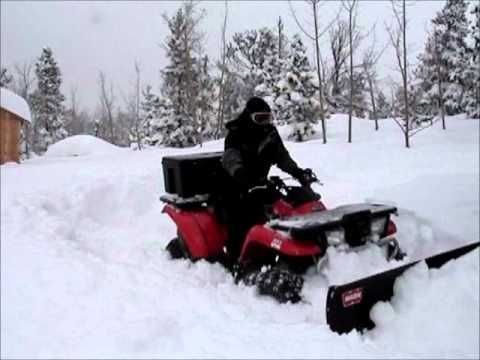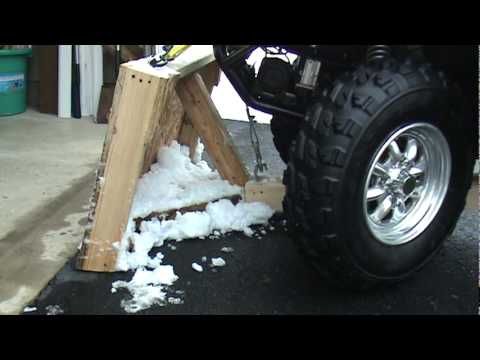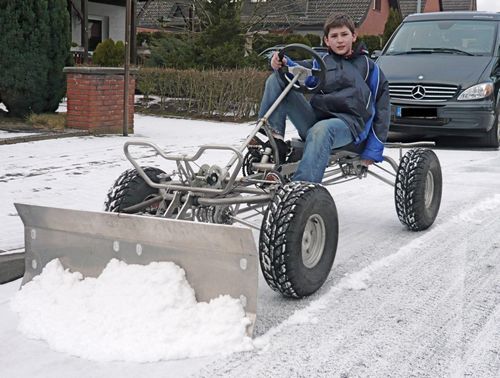ATV snow plow plowing snow with ATV plowing snow with UTV snow plow tips snow plowing tips UTV snow plow
Instead of retiring your ATV for the winter season, consider using that summer toy as a winter workhorse! ATVs can be a simple and efficient way to plow snow from your driveway or other surfaces.
If you have never used an ATV to remove snow, be sure to follow these 8 tips for a smoother and safer plowing process.
1. Make Sure The ATV Has Enough Power
Check the manufacturer's specifications and make sure that the ATV you are using is powerful enough to attach a plow on and remove snow. If you overload your ATV, the best case scenario is that you will have trouble plowing through the snow. Worst case: you can damage your ATV and cause bodily injury. Never overload your ATV!
2. Do All Of The Proper Maintenance Before The First Flake
Working on any vehicle in frigid temperatures is never ideal. Make sure your ATV is tuned up and in good running condition while it’s still (relatively) nice out. Change the oil, check tire pressure and thread, check electrical wiring, and ensure all elements are debris-free and working properly. Review “ 9 Ways to Keep Your ATV or UTV in Peak Condition ” for more detailed tips.
3. Make Sure The Depth Of The Plow Is Adjusted Correctly For The Job
The plow depth needs to be set at the perfect spot where it clears the snow without overloading the ATV and so that it does not damage the surface underneath. You may have to change the plow depth when you are plowing on different surfaces and with varying depths of snow.
4. Determine The Best Angle For The Plow And Set The Angle As You See Fit
The proper angle of the plow depends on the driveway or surface that is being plowed. Consider how much snow is present and where you want the snow to end up. Getting the angle set right will make the snow plowing effort much easier and cleaner.
5. Avoid Especially Deep Or Heavy Snow Drifts
Plowing through snow that is too deep or heavy will overload the ATV and cause more wear and tear on the vehicle. Deep snow drifts may need to be plowed at an angle taking a little of the snow at a time, and going back over the area a few times.
6. Be Cautious Of Items Hidden Underneath The Snow
Landscaping features, curbs and kids toys are known to hide underneath snow, damaging the plow and making the plowing process unsafe. For those static items like landscaping features, considering adding poles or other labels to indicate where they are. To avoid other hidden items, put away any unnecessary items before snowfall to avoid them getting buried.
7. Plow With The Natural Contours Of The Surface
If you follow the natural slopes of the driveway or other surfaces you are plowing, you make the plowing and snow placement easier. You also avoid damaging the plow blade by hitting the ground in uneven areas.
8. Perform a Final Clean Up Before Storing the ATV
Clean all of the dirt and snow off your ATV and plow blade after snow plowing. If you don't remove the snow, ice and dirt clumps right away, they can freeze and get stuck to the plow or ATV. This will make it a more difficult process to plow the snow next time.
Using your ATV to plow snow can help make the chore more efficient and, dare we say, fun! Following these eight tips will help prevent damage to your vehicle, your property and yourself!
4/13/2020
Ready to have some fun plowing snow with your ATV/UTV this winter?If it’s your first time plowing with an ATV/UTV, there are a few things that are helpful to know before you start. With a little practice, you’ll figure out what works best for you, but here are some tips to save you from learning everything the hard way:
The most important thing to remember is to plow with the storm! Don’t wait until there’s 10 inches of wet, heavy snow on the ground before starting to plow. An ATV/UTV can handle just about any winter storm, but the key is to start early. The heavier and deeper the snow, the harder it’s going to be on your vehicle, so when a big storm blows through, don’t wait until it’s over to start on the driveway.
An ATV/UTV can handle just about any winter storm, but the key is to start early. The heavier and deeper the snow, the harder it’s going to be on your vehicle, so when a big storm blows through, don’t wait until it’s over to start on the driveway.
TIP- Plowing soft surfaces: We have found that having a thin layer of packed snow on a soft surface such as dirt or gravel really helps. Drive a vehicle back and forth over the snow first and let it pack down between 1 to 2 inches before plowing.
Treat your ATV/UTV and plow equipment with respect. Ramming into hard-packed mounds of snow can bend the plow blade, damage the vehicle and cause injury to the rider or passenger. Plowing at high speeds is also dangerous, as there can be hidden objects or a buildup of ice underneath the snow. Running into these obstacles at high speeds could seriously damage the vehicle or cause injury to the rider or passenger. If you need to plow a large drift, lift up the blade (but not all the way) and plow the top half. Then come back and plow the bottom half.
Then come back and plow the bottom half.
Push the snow out into the yard at the beginning of the season, so that by the end of the season, you still have a full width of driveway to plow. Come February, you don’t want to find that you have nowhere left to push the snow! To keep from ripping up the yard, lift up the blade a couple inches to skim the grass or lower the skid shoes to raise the blade.
If you need extra traction and stability, secure some weight to the back of the ATV/UTV and invest in some tire chains.
Don’t assume your plow will always work perfectly. Regardless of which system you select, you must examine it before, during and after each usage. Inspect before you plow for loose parts or winch cable damage, for example. Inspect it while you plow to prevent ice buildup, which can make pushing snow more difficult. Finally, inspect after you plow so you know it will be ready to go the next time you need it. Plus, if you find any damage, you’ll have time to order new parts before the next massive snow storm hits.
Finally, inspect after you plow so you know it will be ready to go the next time you need it. Plus, if you find any damage, you’ll have time to order new parts before the next massive snow storm hits.
If using a winch to lift your plow, keep in mind that your vehicle battery may require charging after extended usage. Also, the winch cable may need to be straightened out every now and then. To do this, unhook cable from plow and shift winch into free-spool mode, then pull winch cable out most of the way, leaving a few wraps to secure cable to winch drum. Then shift winch into lock mode and reel cable into the vehicle with slight tension applied to hook strap to straighten the cable
After each heavy snowfall, the owners of parked cars need to somehow get out on the road by car. And if the desire to leave has matured only a few days after the passage of the cyclone, the task becomes much more complicated.
Maxim Stroker
When you go out to your car in the morning and find that a dozen centimeters of snow have fallen during the night, this is, by and large, not a problem. A snowball light as fluff, even of such a height, is easily and without consequences pushed by the bumper of the car. Much worse, when a snowplow managed to drive past a parked car and heat up an impressive parapet across the entrance. You can't get away with a bumper here. However, if it appeared relatively recently, no more than a few hours ago, a few energetic kicks will allow you to clear the passage of your car. As long as the snow has not had time to pack, this is enough. True, if a fragile girl or a young man in elegant office shoes turns out to be the main character of this action, then such “physical education” will inevitably end with completely wet feet.
The feeling of icy limbs is not to everyone's taste, so as an alternative to wet feet, a snow shovel is required. Or some other improvised entrenching tool - like a suitable board, for example. Not every car owner keeps something like this on the farm, and therefore, most likely, you will have to run for a shovel or take public transport to the nearest specialized store. Or resort to the help of a friendly janitor, who has heaps of these shovels. The most difficult option is when we have a high snow parapet in front of us, which has stood for several days.
Not every car owner keeps something like this on the farm, and therefore, most likely, you will have to run for a shovel or take public transport to the nearest specialized store. Or resort to the help of a friendly janitor, who has heaps of these shovels. The most difficult option is when we have a high snow parapet in front of us, which has stood for several days.
This is what happens when the car owner does not leave the parking lot for several days, fearing difficult driving conditions during a long snowfall. Snow, piled in a heap, has time to pack heavily in a few days, and an ordinary snow shovel is no longer suitable for cleaning it. In this case, you will have to get a bayonet shovel somewhere. Or at least a sapper - only with such a tool will it be possible to cut through a snowdrift. And such an operation will require a noticeable amount of time. But even after digging out the car and making a tunnel for it in a snowdrift, you can get stuck if you don’t use a couple of tips.
Firstly, when driving out of a snowdrift, it is imperative to turn off the ESP or any other exchange rate stabilization system in the car so that the engine does not “choke” every time one of the wheels slips. Secondly, if you press on the gas, and the car is slipping, but not moving, you are unlikely to be able to leave. In this case, you need to back up a little and take a little acceleration to slip through a slippery place. Or, if we are talking about a front-wheel drive car, try turning the steering wheel in different directions - such a change in the direction of their rotation very often helps the tires “hook” and pull the car forward. Well, if none of the above methods helped to leave - there is nothing to do, you will have to look for a tug car that will be able to pull yours out of snow captivity. Or wait for spring when the snow itself melts.
103299
We get acquainted with the "average brother" in the Russian line of sedanov VW
72570
We are introducing to the "Middle Brother" in the Russian line in the Russian line VW sedans
72570
0001
When they have free time, city dwellers, as a rule, tend to get out into nature and spend their leisure time cheerfully and actively. The most popular pastime among people of all ages is quad biking. Such trips give a feeling of freedom, endless drive and a sea of positive emotions. In addition, maneuverable and highly passable transport allows you to visit those places that are inaccessible to any other equipment. All-weather and all-terrain adventures are possible on four-wheeled ATVs, as the wide wheels easily cut through mud and snow, while the deep tread tires provide excellent traction.
The most popular pastime among people of all ages is quad biking. Such trips give a feeling of freedom, endless drive and a sea of positive emotions. In addition, maneuverable and highly passable transport allows you to visit those places that are inaccessible to any other equipment. All-weather and all-terrain adventures are possible on four-wheeled ATVs, as the wide wheels easily cut through mud and snow, while the deep tread tires provide excellent traction.
ATVs began to be sold in our country only 20 years ago, but their history began at the end of the 19th century. The prototype of the modern off-road vehicle, which was a bicycle designed on four wheels, was presented to the general public at an industrial exhibition in New York in 1853. The model was equipped with a passenger seat and developed a good speed.
Modern all-terrain vehicles differ significantly from their predecessors not only in appearance, but also in technical capabilities and equipment. The models on the market belong to one of four classes
The models on the market belong to one of four classes
 The design of the cars is fully adapted for travel: it includes a spacious trunk, cabin, passenger seat and body with hydraulics. Touring models are four-wheel drive with a reduction gear, and low pressure in the tires allows you to pass through sand, snow and slush.
The design of the cars is fully adapted for travel: it includes a spacious trunk, cabin, passenger seat and body with hydraulics. Touring models are four-wheel drive with a reduction gear, and low pressure in the tires allows you to pass through sand, snow and slush. All off-highway vehicles are highly reliable, but normal wear and tear of parts or heavy use of machines often cause various problems in ATVs. In sports models, for example, the power unit, transmission and suspension parts often fail, so the main spare parts for sports ATVs can be electric starters, shock absorbers and variator belts, etc. The following signs signal that it is time to check important vehicle components , how:
The following signs signal that it is time to check important vehicle components , how:
For your own safety, riders are advised to contact a professional who has extensive experience in troubleshooting any problem and replace damaged parts with original parts made by trusted ATV parts suppliers. This will ensure that the parts are fully compatible with each other and guarantee long-term operation of all SUV components.
Another vulnerable part of motorcycles are the body parts that suffer in the event of rollovers and collisions. As a replacement, frame and fastening parts, steering wheel parts, lining, pedals and footrests are used.
You can buy spare parts for all types and models of ATVs from the largest supplier of accessories and spare parts for off-road vehicles - the company "Quadrostil". The supplied products are made of durable materials resistant to corrosion processes and deformations. All products meet modern standards and are quality tested at all stages of production.
Kvadrostil has its own online store, which presents thousands of products with different purposes and functionality. The widest range allows buyers to choose the product that best meets their needs. So, in the spare parts catalog for ATVs you can find shock absorbers, dampers, optics, consumables, brake pads, drives and much more.
Products are sold wholesale and retail with a guarantee for all models. Delivery of goods is carried out throughout Russia through courier services and transport companies.